QUANTA
S T U D E N T M A G A Z I N E

THE BISHOP’S SCHOOL 2023 - 2024
2 table contents of Synesthesia 6 Invisible Threads — KAILIN XUAN ‘26, AMY YAN ‘26 8 Dreams Decoded — CALISTA UPTON ‘26 10 Memories — CHLOE HINDER ‘26 Symbiosis 12 Accidental Creation of Angry Hamsters — SOPHIA HAYDEN ‘ 25 14 The Heart of Innovation — TALI BEN-YEHUDA ‘25 16 Gemstones in Technology — JASPER ROSE ‘30 A Summer of STEM 20 From Code to Field: Robocup 2023 — AUDREY LIN ‘25 24 Refocusing the Lens — EMMIE KAO ‘ 25 Society 28 Women in STEM — PAULINA AI ‘ 24 30 Girls in STEM at Bishop’s — SERENA ZHANG ‘ 24

F E A T U R E
D
14 A SUMMER OF STEM
Invisible Threads: Your Life’s Subconscious Pupeteer; a compelling exploration into what we know and what we don’t see BY KAILIN
AND AMY YAN
XUAN
The Accidental Creation of Angry Hamsters: They may be cute pets, but what do they become when just a single neural receptor is removed? BY SOPHIA
HAYDEN
Gemstones in Technology: Though they may be “rare,” gems are actually very common in our everyday lives. BY JASPER ROSE
Robocup 2023: Bishop’s Students in France. Hear about their experience participating in an international robotics competition! BY AUDREY LIN
Read about STEM stories from Bishop’s students this summer.
3

Dear readers,
As I reflect on my last year at Bishop’s, I’ve realized that the end of this chapter also marks the beginning of new things. It can be scary, but also rewarding, to delve into the unknown. If you picked up this magazine, whether you’re either a frequent Quanta reader or trying something new, we’re glad you’re here.
In science, we are always on the brink of something new, whether it’s finally understanding how watches and clocks work (read more on gemstones), or diving into scientific research and international science endeavors (read about Bishop’s students’ summers full of STEM). No matter how familiar you might be with the topics of these articles, Quanta is a way to tap into our natural curiosity and to wonder about the world around us.
From learning about the fascinating inner workings of our minds, to exploring the STEM community globally and at Bishop’s, this issue of Quanta is a deep dive into being human. How do we think about ourselves and our world, and how do we interact with others? What parts of everyday life go unnoticed? I hope you continue to ask these questions, not only during the time when you are reading these articles, but afterwards.
I’d like to thank our amazing staff of writers, editors, and layout designers who have put a tremendous amount of effort and collaboration into this issue. In addition, we are grateful for the guidance of the science faculty, without whom, this would not be possible. Lastly, we thank you for picking up our magazine. Happy reading, and stay curious!
Best,
 Serena Zhang Editor-In-Chief Class of 2024
Serena Zhang Editor-In-Chief Class of 2024
E D I T O R
L E T T E R
4
‘
S

The process of scientific discovery is, in effect, a continual flight from wonder.
- Albert Einstein
Your Life’s Subconscious Puppeteer INVISIBLE THREADS:
By Kailin Xuan ‘26 and Amy Yan ‘26
Imaginea puppeteer pulling the strings in the shadows, controlling the show while you remain blissfully unaware. This puppeteer is your subconscious mind, quietly dictating the course of your life.
Consciousness refers to thoughts in the present moment and does not involve stored information from the past. In contrast, your subconscious mind remains unaware but stores all past information about every experience, thus affecting habits, reactions, and the body in general. The subconscious mind consists of a homeostatic impulse, which regulates body temperature and heartbeat while balancing hundreds of chemicals among billions of cells without you having to ever pay attention to it. It works restlessly, even when asleep, but thankfully beyond our awareness. Can you imagine how difficult life would be if we had to make conscious efforts to move every single muscle each time we took a step, a breath, or swallowed and digested food? There would be no room to process higher thoughts; all our mental energy would be focused on physiologic survival.
The stubborn subconscious mind also controls human emotional responses, decision-making, and problem-solving. In fact, Harvard Business School professor Gerald Zaltman writes that 95% of a consumer’s decision-making process is directed
by the subconscious mind. In addition, the subconscious mind does a large amount of problem-solving for you. A study by Stanford biologist, Bruce Lipton, found that the conscious mind processes information at the rate of roughly 40 bits per second, while the subconscious mind can handle upwards of 20 million bits of information a second, signifying that the subconscious mind is 5000 to 2 million times faster than the conscious mind. This is a reason why, after being stuck on a problem, taking a break from it by going on a drive, a stroll, or a jog can sometimes actually help you solve it more effectively and discover the solution. By participating in these mildly stimulating activities and removing constant thoughts on the specific problem, we allow the subconscious mind to take charge of the information processing function, leading to new solutions.
We learn subconsciously more than we do consciously. In fact, one model of learning describes us as mistakenly thinking we have not retained the information, while really, we have, but at a subconscious level. (Subconscious learning) This subconscious learning also applies to different experiences we face in life. By retaining these past experiences, the subconscious mind can make predictions for the future, both positive and negative, based on past trends.
6
For example, if you experienced bullying as a child, those memories remain in your subconscious: As an adult, if someone attempts to compliment you, your subconscious mind may interpret the gesture as sarcastic when it wasn’t. Fortunately, though, it is possible to “retrain” the subconscious mind and use it to your advantage. By persuading your subconscious mind to adapt to your current goals, you let go of old methods of thinking in order to improve subconscious ideals, much like quitting a bad habit. Chad Chesmark, author of How to Predict the Future By Creating It Yourself, has suggested using different psychological tools, such as hypnosis, in order to make this process easier. Through hypnosis, Chesmark has helped countless individuals during weight loss journeys as he is able to promote certain decisions that can change their bodies. Think of it like altering “their brains’ programming to reach for healthier foods rather than junk food,” thus letting go of their “bad habits” and creating new subconscious projections that guide people towards fulfilling their goals
We learn subconsciously more than we do consciously.
. The unrealized potential of the human subconscious mind is revealed by ongoing scientific research, such as the most recent discoveries about how even animals learn from subconscious impulses. This could eventually lead to a ground-breaking future for society, ranging from personalized treatments based on the unique subconcious effects each patient experiences to even advanced neurofeedback systems that assist individuals in regulating their emotions. There is even potential for improvements to technologies like the brain-computer interface (BCI), which helps people with disabilities directly send commands to machines and prosthetics, simply through the power of their thoughts. However, to this day, it is not certain that we will ever fully grasp the intricacies and mysteries of the mechanics of the brain, including the subconscious mind. The enigmas of our thoughts, experiences, and the mechanisms governing the mind will forever define the profound mystery of being human.
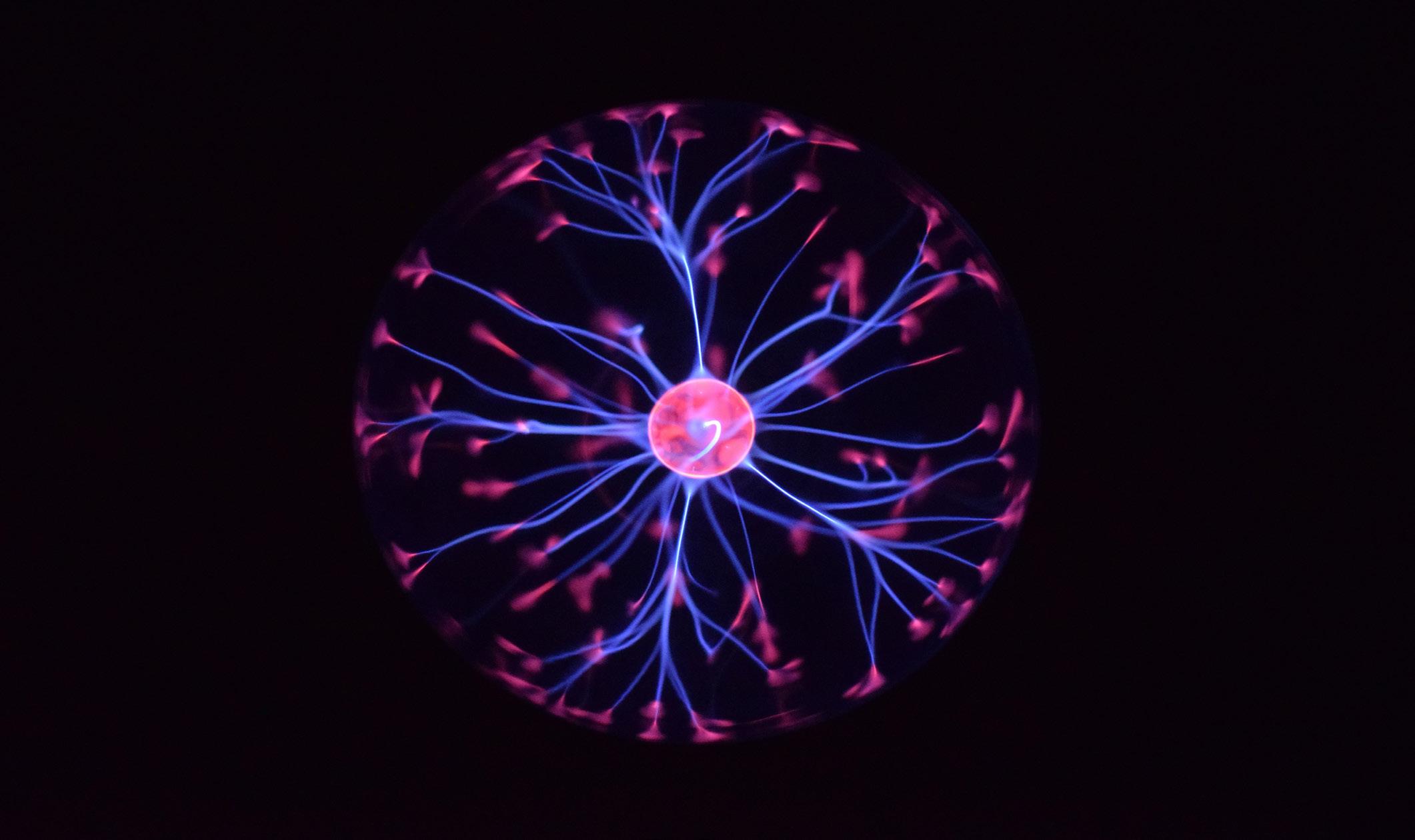
7
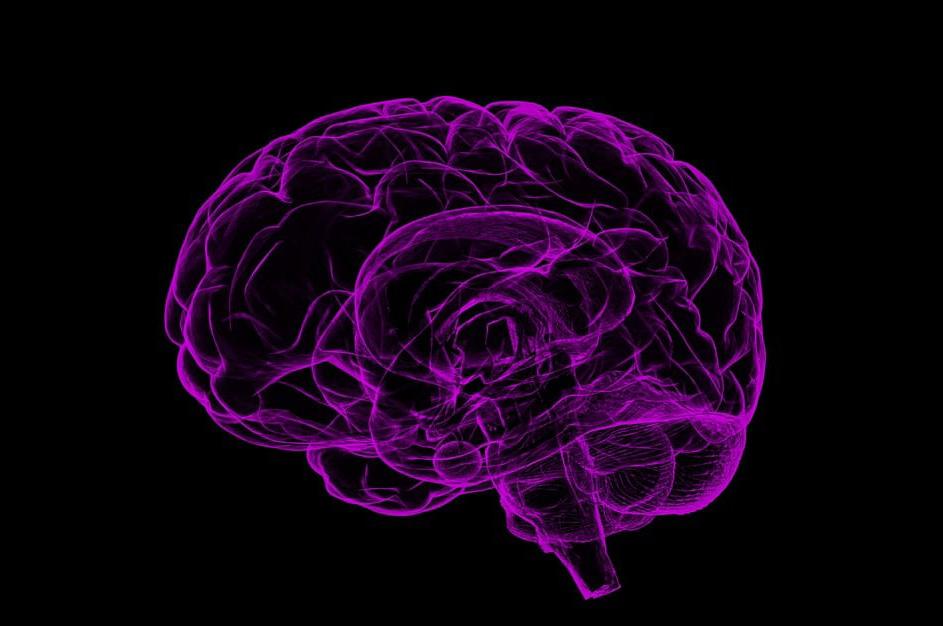
DREAMS DECODED
A Scientific Exploration of the Sleeping Mind
by Calista Upton ‘26
The first thing to understand about dreams is the different phases of sleep. There are four stages of sleep that can fall under two groups: NREM(stage 1,2,3) sleep and REM(stage 4) sleep. Throughout the night, your body will go through stages 1-4 and then repeat, creating cycles.
Stages 1 and 2, known as N1 and N2, are light sleeping, where the N stands for non-REM sleep. Stage 1 only lasts for 1-7 minutes and is the shortest stage while phase 2 is the longest where most people spend half of their sleep. Stage 1 is when you are first falling asleep and stage 2 is when the brain and eye movement start slowing down. The body starts going into a deep sleep in Stage 3(N3) and during the early cycles, this stage is 20-40 minutes. As you continue
sleeping, however, the stage gets shorter. REM(rapid eye movement) sleep is stage 4 and dreams that are remembered are usually from this stage. The REM sleep stage can only be entered after about 90 minutes of sleep. At the start, you spend less time in this stage, but as you continue sleeping and going through cycles, the time during stages 2-4 decreases while the time for the REM stage increases. About 75% of sleep is during NREM(non-rapid eye movement) stages. It’s suggested to get at least 8 hours of sleep every night, as there should be 4-5 sleep cycles per night with each cycle lasting 90-110 minutes.
Most people have different ideas of why we get specific dreams or if they are random. An example is Sigmund Freud, an Austrian neurologist who
claimed that dreams were hidden messages from a hidden part of the brain and unconscious mind. While this might be true, there is no scientific evidence to support this. Neuroscientists today have found that dreaming most likely reflects a post-processing of a memory in the sleeping brain which psychologists call memory consolidation. They discovered different patterns of brain activity representing that memories are replayed when we go to sleep. There are cells in the human brain called place cells that only become active when humans are in familiar environments and stand in a specific spot. Throughout the day when we are moving, especially if we have an everyday routine, those place cells
Lucid dreaming is a type of dream where the person realizes they are in a dream and can take control of the dream. Lucid dreaming is very rare, with only about 1% of people having lucid dreams regularly. Lucid dreams typically happen in the REM phase of sleep. During lucid dreaming, there is increased brain activity in areas that relate to higher cognitive functions (working memory, attention, self-consciousness, and planning). A neurological study showed that with lucid dreamers, there is more brain activity in the prefrontal cortex, which is responsible for self-reflection and planning. Researchers from this study have found that the likelihood of lucid dreaming is higher for people with
Dreams are hidden messages from the brain and unconscious mind.
form a sequence that represents our real-life experiences. During dreams, these experiences will start playing back again because the repeating sequences from the place cells make us feel as if we are moving.
A study at Notre Dame explains why sleep is so good for memory. In the study, it was found that when we learn something before going to sleep, we will remember that information better later on. In another study, it was found that if you learn information before sleeping and then dream while you sleep, you will remember the information 10 times better than if you don’t dream about it. This may explain some dreams, but other dreams can seem bizarre and not relevant, such as something that is not real. Although it might seem random, this is when your dream is just taking bits and pieces of different memories and putting them all together to make one unrealistic dream.
better cognitive functions and a more developed prefrontal cortex. Sigmund Freud’s theory that dreams represent unconscious desires, thoughts, and motivations is very similar to the idea that lucid dreams are a hybrid state of being awake and being asleep. This hybrid state is when the dreamer experiences images and sensations that take place in a normal dream but with characteristics of awake thoughts.
In conclusion, I chose to write about dreams because the study of dreams shows the interesting dynamics through sleep cycles and distinct phases of dream activity. From these light sleeping stages of NREM to the vivid dreams of REM sleep, each phase plays a specific role in sleep. Comparing what people such as Sigmund Freud used to believe and what modern neuroscientists have found today is helpful in understanding how science has evolved. Lucid dreaming is also something that I found to be a fascinating subject because even today it doesn’t seem to be something fully understood by scientists.


Memories
by Chloe Hinder ‘26
10
OnDecember 24 2012, an experiment by scientists Steve Ramirez and Xu Liu had a finding which dramatically changed the way that people saw and understood memories. They successfully implanted a made up memory into the brain of a mouse, finding that when they placed the mouse in a box it froze in terror remembering being shocked. This memory- a foot shock - that never actually happened. Ramirez and Liu had surgically implanted filaments from a laser through its skull, activating fear. This finding proved that the brain cells encoding a certain memory could be manipulated to make a whole new one from something that never happened. These discoveries could pave the way to new treatments for disorders such as depression, Alzheimer’s, PTSD and more.
Memories have crucial effects on people; they can change almost everything about who a person is. People from different backgrounds, cultures, households, schools, countries, and more have vastly different experiences and approaches to day-to-day life. But how does this work? Why do memories change so much about a person?
To understand the ways that memories affect people so much, it is important to understand what a memory is and how one is made. By definition, a memory is a place in someone’s brain that stores data which can be retrieved when needed. Memories happen when specific neurons formed by neurogenesis, which are responsible for different thoughts, reactivate from changes in strength of their connections. This happens because of something called synaptic plasticity which is the changes in strength of connections (synapsis) between brain cells. Connections which are used frequently get stronger and ones that are not get weaker and can even disappear. Thus certain memories stay and others fade away.
While it can be beneficial to lose some memories and replace them, it can also be very helpful to improve them, even long-term. Sleep and exercise are already essential to someone’s health and well-being but they have also been proven to improve people’s memories. Exercise has shown to
enlarge a part of the brain called the hippocampus, so that more neurons are being created. This resulted in people who have exercised receiving better results than those who have not on memory tests. Sleep is also essential since it is the only time when the hippocampus and the neocortex (a part of the brain responsible for sporadic memory and where thought occurs) communicate. In this process, the hippocampus tells the neocortex what needs to be stored. Because of this, sleep and exercise are key to a healthy body and a healthy mind.
While Ramirez’s and Liu’s study was performed on a rat, false memories — implanted or not — can still have significant impacts on people. A study done at the University of Warwick in England showed that 50% of people were susceptible to believing falsified facts and were convinced they had experienced the fake memory, 30% even remembered this event and could recount details and descriptions of what happened. This way of implanting untrue memories worked because it is so hard for people to remember past events precisely. In everyday life, this can be a huge issue, even in court cases when there have already been fabricated confessions. This is especially important during a time of social media where made-up information is spread to millions of people, confusing people’s true memories of a certain event. Because of this, it is necessary to keep in mind the spread of misinformation and recognize the ways that the extent of research can have large effects on someone’s perception and understanding of a subject.
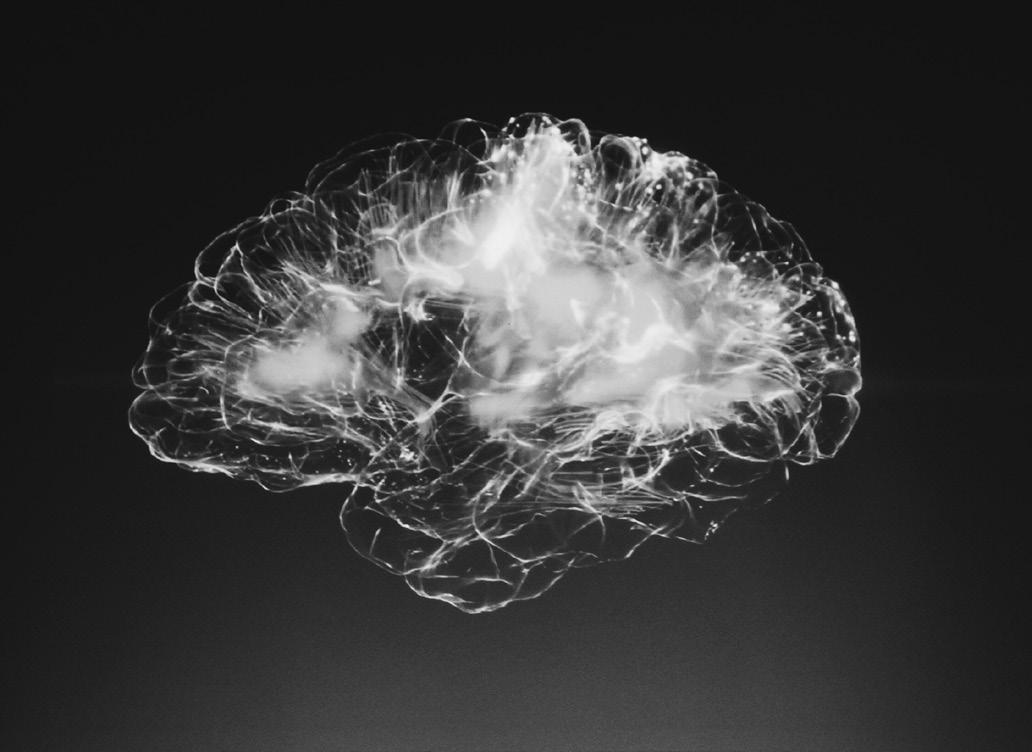
11

Genetically Modified: The Accidental Creation of Angry Hamsters
By: Sofia Hayden ‘25
Hamsters
have a long past in scientific research. Not the hamsters themselves, obviously, but the researchers who have performed experiments on them. They have led to important discoveries in cardiovascular diseases, diabetes, cancer, and most recently, COVID-19. Scientists have found that hamsters possess several qualities similar to humans, making them ideal for such research. Specifically, there are many similarities between our social behaviors and theirs. One such example is that their stress response is the same; both humans and hamsters release cortisol when faced with an obstacle. That is why curiosity among several scien-
tists sparked when a group of genetically modified hamsters began behaving in unexpected ways.
In the spring of 2022, a team of researchers at University of Georgia, led by Professors H. Elliot Albers and Kim Huhman, observed what would occur when they eliminated a particular receptor in hamsters that regulates vasopressin—a hormone essential for communication, bonding, and aggression. This receptor—Avpr1a—was removed using CRISPR-Cas9 technology. CRISPR-Cas9 is a gene modification tool that can be used to target specific regions in the DNA to change it, thus allowing for the elimination of certain genetic disorders, or in
12
the case of these hamsters, completely removing one of their brain’s functions.
The removal of Avpr1a was thought to significantly reduce the effects of vasopressin in the hamsters. Professor Albers conveys that “We anticipated that if we eliminated vasopressin activity, we would reduce both aggression and social communication.” This makes sense; —if what allows vasopressin to perform its function in regulating these hamsters’ social behaviors is missing, then the hamsters’ social interactions should also decrease. This means less aggression and less interaction. This hypothesis could not have been more wrong. What occurred instead was a tremendous increase in violence, hostility, and assertiveness towards other hamsters. Their levels of communication also dramatically increased. In addition, the usual differences between male and female hamsters were significantly reduced; both were involved in similar amounts of aggression and flank marking.
This revealed that the functions of vasopressin and Avpr1a were much more complex than previously thought. Professor Albers remarked that “Even though we know that vasopressin increases social behaviors by acting within a number of brain regions, it is possible that the more global effects of the Avpr1a receptor are inhibitory.” Instead of causing aggression in hamsters, it seemed that the function of Avpr1a was in regulating it. By removing the Avpr1a receptor, there was nothing that could control for the excess of vasopressin, resulting in more violent behaviors in hamsters.
The gain from this knowledge not only resulted in a greater understanding of the hamster brain, but also led to significant progress in discerning human behavior. The unexpectedness that arose from altering the brain chemistry of these hamsters allowed these researchers to understand that the role of vasopressin and the Av1pra receptor were essential in regulating aggression, not provoking it, as they had thought. Understanding how the hamster’s brain is wired can be key to unlocking several of the mysteries about the human brain. In the long term, studies such as this one can even help in finding new treatments for those suffering from a neuropsychiatric disorder.




Thetoptwoimagesshowamalemarkingthe corners of the box. The bottom two show a female pinningdownanotherfemale.
13
The Heart of Innovation
AIPoweredSafety,Efficiency,andAccuracyinDetectingHeartDisease
By Tali Ben-Yehuda ‘25

Coronary artery disease kills hundreds of thousands of people every year. The CDC reports that in the United States, a person dies from cardiovascular disease every 33 seconds. In 2021, 1 out of every 5 deaths were cardiovascular, and on average, 805,000 have a heart attack. Of those 805,000, first-time heart attacks comprise 605,000, and 1/5 of heart attacks are silent, meaning that the person having the heart attack is unaware of the damage being done to their heart. So, how do people know if they’re at risk for this destructive and dangerous disease? The “gold standard” for the evaluation of risk for coronary artery disease is Fractional Flow Reserve, or FFR. Coronary artery disease is caused by plaque buildup in the arteries, which provide the blood supply to the heart. This plaque is made up of cholesterol, deposited, the arteries become clogged, and the ability of blood to travel through them is weakened. These blockages prevent the heart from getting an adequate
supply of blood, which is what causes heart attacks. In order to determine which treatment is necessary to open the blockage, two processes are performed. The first is the angiogram, which uses contrast dye inserted through the veins in order to produce images of the arteries and visually determine where the blockages are and their degree. FFR uses a catheter, a thin tube which can be inserted through a vein and into the coronary arteries, to assess the ratio of pressures on either side of the blockage. The normal, healthy ratio is 1, indicating blood can completely flow through the artery. An FFR of .80 or less indicates a severe stenosis, which means that treatment, such as stenting or bypass surgery is needed in order to open adequate blood flow to the heart. This clear, direct determination signifies which method of treatment is best for the patient. Fractional Flow Reserve is vital in ensuring that the right patients are selected for treatment and avoiding performing unnecessary procedures.
14
However, because an extra catheterization is needed, there are several downsides. The procedure is more expensive and time-consuming, and can lead to complications such as excessive bleeding due to the blood thinners used, and the wire itself can cause tears in the arteries. However, using Artificial Intelligence, FFR
Fractional Flow Reserve is vital in ensuring that the right patients are selected for treatment
can be evaluated using only the angiographic images, making the procedure less invasive, safer, more efficient, and cheaper. Medhub AI has produced one such software. The AutocathFFR software processes images using a complex algorithm based on machine learning strategies which can determine results in less than a minute. The software first vets the angiographic images in order to ensure that they are of sufficient quality to be analyzed. This algorithm was prepared using 13,000 angiographic procedures encompassing millions of individual images, and learned to identify specific features of these images, enabling it
The emergence of AI technologies for disease detection and treatment signifies radical progress towards more efficient, accurate, and safe procedures.
to sort through the images and find the frames which will most effectively and accurately determine FFR. The algorithm was then trained using frames with pre-marked blockages, cardiovascular structures, giving it the capacity to identify the structure and features of various images of the heart. The last step was teaching the AI how to estimate the FFR value by comparing the features identified during the analysis step of the algorithm to the result found in previous invasive FFR procedures.
Using this information, based on the analysis of thousands of previous cases of invasive FFR, the AI software is capable of deriving accurate FFR values using only the angiographic images. The software can analyze the entire cardiac circulatory system in less than a minute, improving procedural efficiency, reducing costs, and mitigating the risks of additional complications. As this software is seeking approval from the FDA to be used in real clinical cases, a study was performed between two institutions in the United States-
The software can analyze the entire cardiac circulatory system in less than a minute
UCSD and Washington Hospital Center. Each institution retroactively analyzed FFR cases and compared the previous invasive results to results found through the software’s own analysis. As a research assistant for this study, I participated in the entry of data into the software, which would go on to be analyzed and compared to the expected FFR results. The emergence of AI technologies for disease detection and treatment signifies radical progress towards more efficient, accurate, and safe procedures. Artificial intelligence is extending its reach into numerous areas of medicine, from digital medical records to analyzing radiology examination, and is rapidly changing the field of healthcare itself, making procedures and diagnoses safer, more accurate, and cost-effective.
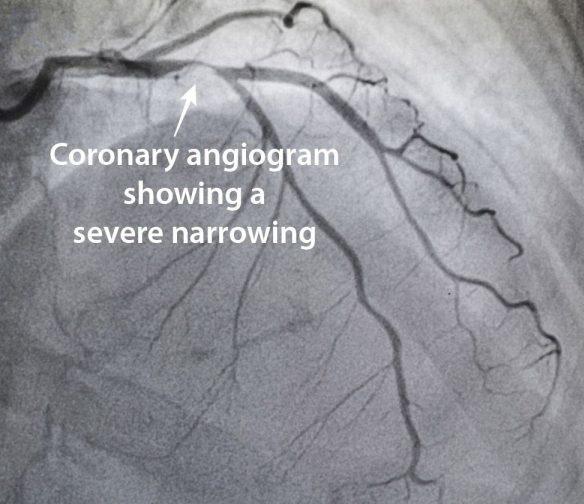
15
Uses of Gemstones in Modern Technology
By: Japser Rose ‘30
From microchips, to clocks, to lasers, gems and minerals have many uses in modern technology. They have found a place in everyday life, and in the most cutting edge experiments. In fact, only about 100 minerals are classified as gemstones, and only about a dozen are commonly used in jewelry. The rest are used mainly for industrial or technological purposes. Here are just a few of the most common uses of them in technology.
Gemstones play a major part in the technology of lasers. The first laser, created in 1960, utilized a ruby crystal to amplify and focus the light of a high power lamp. Now, synthetic gems are often used in lasers, as they are usually higher quality, and have less imperfections.
In the field of optics and lenses, gemstones and crystals play an important role as well. What makes crystals unique is that they have an even structure throughout. If you were to look at the molecules of a crystal you would see a repeating pattern. Because of this, crystals can be used to create clear and almost perfect lenses that are resistant to scratching and shattering. Crystals are used in more than just lenses though. They can even be used in clocks!
A quartz clock is a type of clock that tells the time based on how many times a quartz crystal inside vibrates. Quartz is piezoelectric, meaning that when it receives a voltage, it will oscillate (vibrate). When quartz oscillates, it always oscillates the same amount of times per second, so a clock can count those vibrations to tell when the second is over. These clocks are extremely cheap, and are often used in less expensive watches. But when it comes to microchips, Quartz is outshined by sapphire.
Sapphire is a strong, pure gem. Because of this, and its scratch residence, sapphire is often used to make protective layers in semiconduc-


tors and microchips. Quartz can also be used, but sapphire is better. It is stronger, and therefore can be crafted into smaller pieces, but still have the strength that a larger piece of quartz would have. It is important for technology to be strong and conveniently small. Although sapphire is strong, diamond is even stronger, making it an excellent gem for many things, including technology, and industrial equipment. One of diamond’s main uses in industry is mining.
For drills to be effective, drill bits need to be very durable, or else they will wear down and become useless. Diamonds can solve this problem. Diamonds are the toughest naturally occur-
All minerals have scientific potential.
ring material. Furthermore, diamonds are very heat resistant, and drilling generates a lot of heat. Diamond drill bits are very important in mining. Besides, even diamonds that wouldn’t be used in jewelry can be used for drilling. Synthetic diamonds are also a cheaper but still reliable option. Although diamond is very strong, this doesn’t make it the best for cutting smoothly and efficiently.
Obsidian tools are extremely sharp. The best obsidian tools are several times sharper than steel tools. This makes them perfect for surgery. They cause less scarring than other tools, and they cut easier. This is very important when the surgery requires precise cuts. Obsidian tools are often used on surgeries on areas of thin skin, like eyelids. Although these are a few of the more common uses, there are many, many other ways gems and minerals are used. Gems are often valued for their beauty, but each gem can be used for more than trinkets and rings. All minerals have scientific potential.
READ ABOUT:

Robocup 2023: Bishop’s Students in France. Hear about their experience participating in an international robotics competition!
Differential Dynamic Microscopy: Science in Action. Hear a firsthand account on Emmie Kao’s (‘25) research at the University of San Diego.
summer a of STEM
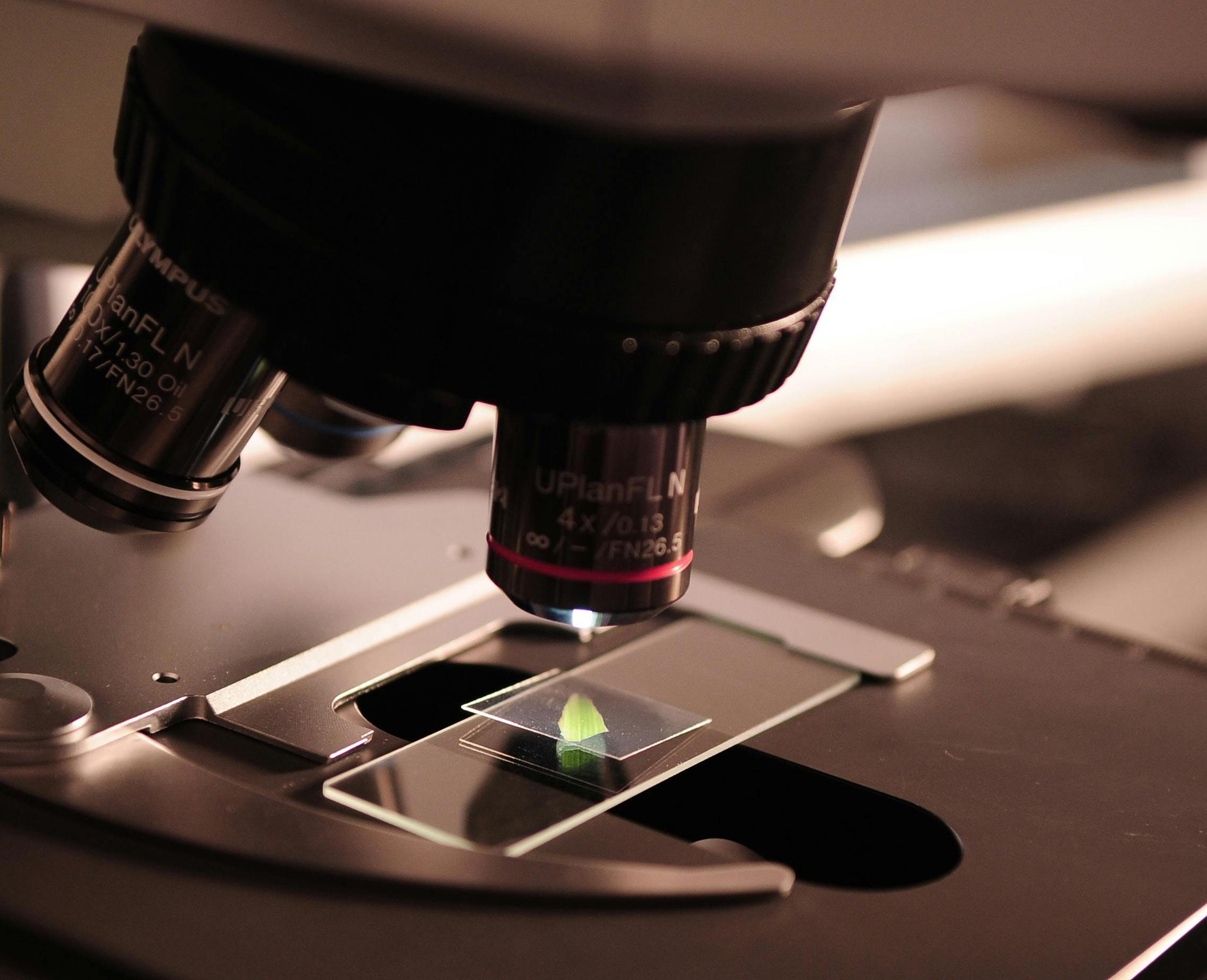
RoboCup 2023

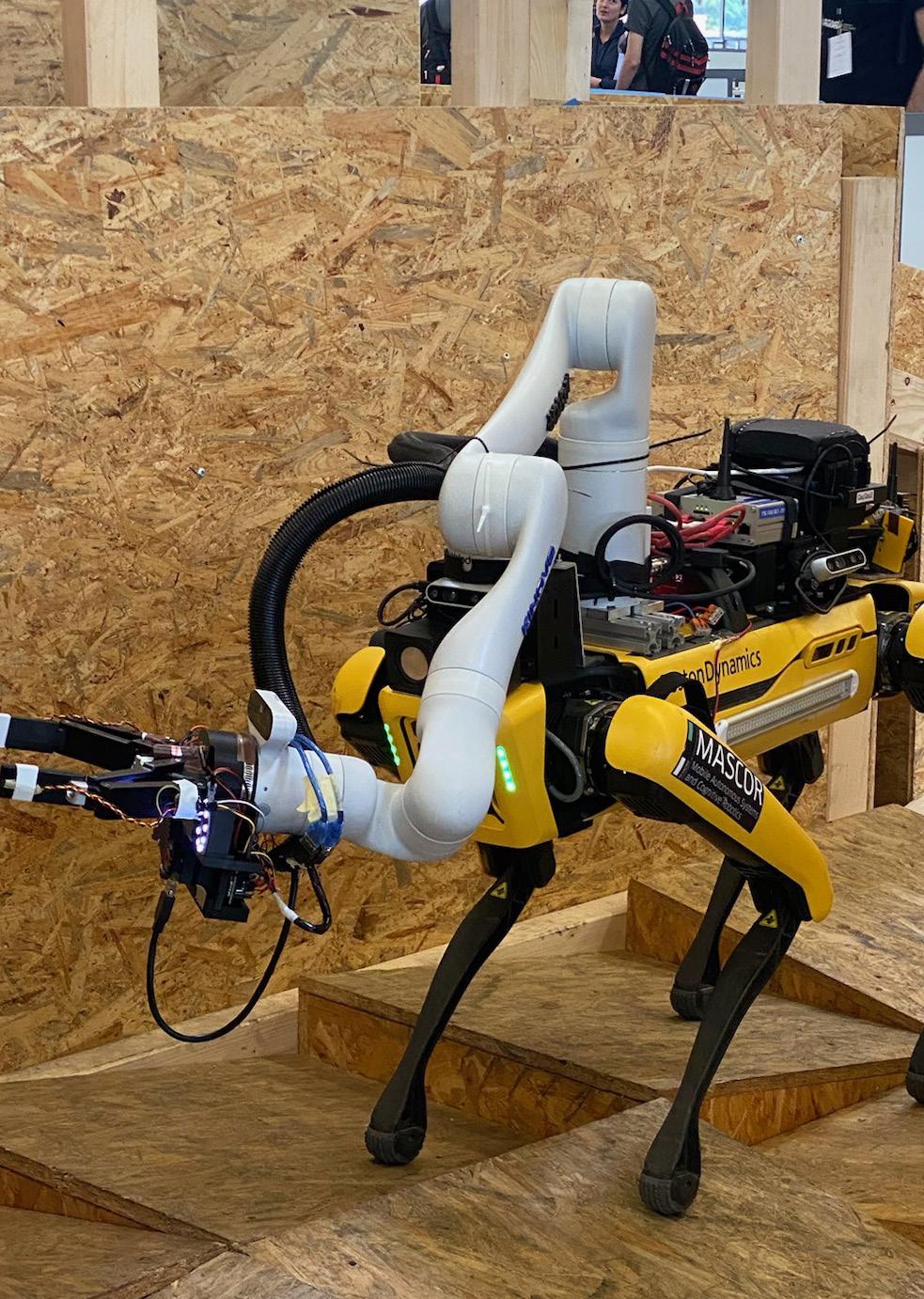


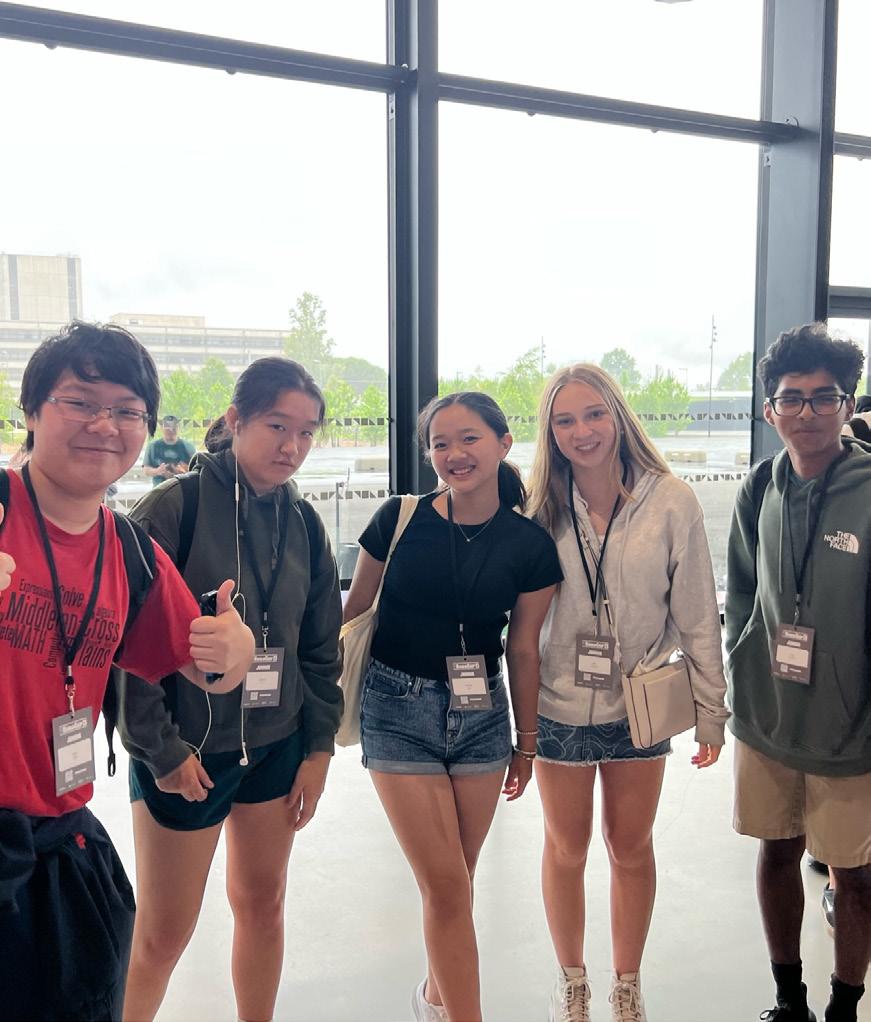
20
From Code to Field: Reflections on RoboCup
By Audrey Lin ‘25
An unnaturally short (as in, shorter than the goal itself) but nonetheless fierce competitor faces its equally pint-sized opponent on the soccer field. The two face off as a crowd of fans — ranging from other competitors to local kids atop their parent’s shoulders — peeks over to watch this showdown. It’s the preliminary matches between teams of NAO Robots at RoboCup 2023, and standing at barely two feet tall, even the gentlest push could cause the robot to tip over.
RoboCup, an annual event, is the biggest robotics and artificial intelligence competition in the world. The 26th RoboCup took place this July in Bordeaux, France, as 2,500 competitors (alongside 2,000 robots) flocked from 45 different countries for a week of competition, with events such as robot soccer, rescue missions, and talent shows. Initially created with the goal of robots playing the 2050 World Cup (hence the name, RoboCup), the international event, which is also open to the public, is now home to a myriad of different events and exhibitions that are sure to



2,500 competitors
2,000 robots
45 countries
all icons from icons8
excite anyone curious about robotics. I, alongside Sienna Li ‘24, Millan Kumar ‘24, Mia Gover ‘25, Ryan Zhu ‘25, and Wu Tsai Chairs Dr. Jaiclin (who is also our coach) and Dr. Keller had the amazing opportunity to travel to Bordeaux to compete in RoboCup as the only American team in the RMRC Rescue League.
RMRC, also known as Rapidly Manufactured Robot Challenge, is one of the many events in RoboCup. In RMRC, the objective is to design a cost-friendly, versatile robot fit for natural disasters, such as an earthquake.


Teams aim to fashion a robot that can bypass a myriad of terrains, including sand, wood, and more while completing various tasks, such as opening doors and reading hazmat labels, making RMRC a test of agility, strength, rough terrains, and more.
I’ve found that the best part of RMRC is that it pushes every single one of us to take what we’ve learned about technology out of the confines of a classroom and use them to solve real world problems. RMRC, as with most RoboCup events, cultivated an opportunity to use our creativity, as every single team competing approched the challenges differently. The Mexican team’s sleek black and gold robot had an incredible height that gave it an advantage on challenges such as climbing stairs. On the other hand, the local French team’s Lego-made and Scratch-driven robot — small and simple, but nonetheless capable. While RMRC is the best event at RoboCup (in my definitely unbiased opinion), there are plenty of other interesting events, and there’s sure to be an option for every roboticist out there. The wildly popular Soccer league drew
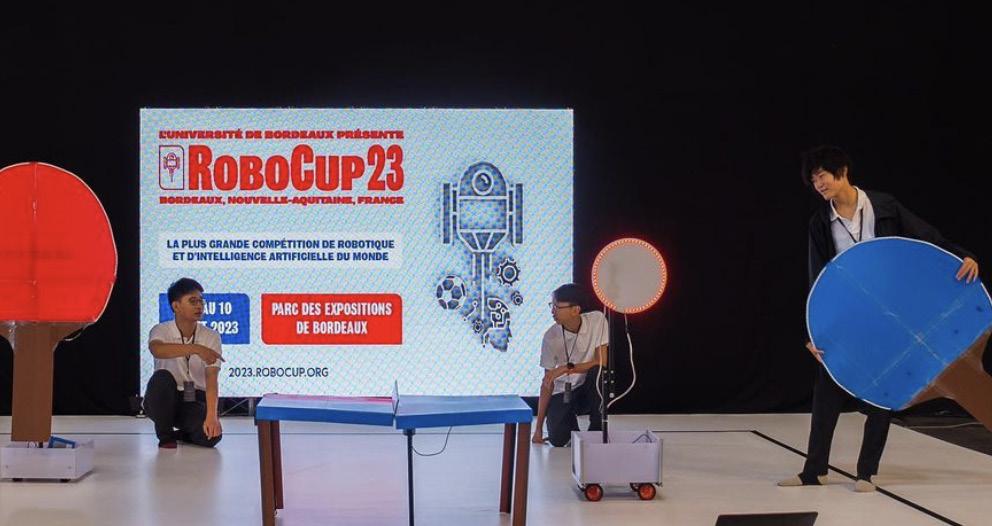
Ping-Pong playing robots! Photo from @robocup2023bordeaux on Instagram
many local kids, as they excitedly cheered on long games. And when I say long, I mean long — it took upwards of 5 minutes for one robot to walk across the whole soccer field. Another fan favorite is the On-Stage event, where robots would put on a performance of anything from snorkeling elephants to reenactments of Star Wars. While the Soccer and On-Stage events served a more entertaining
21
all icons downloaded from icons8
purpose, leagues such as Industry, Home, and RMRC work towards real-life innovation, focused on creating problem-solving robots that may be used one day. Robots from the Industry league are designed for industrial challenges

inside factories, while robots from the Home league are created with domestic environments in mind, such as household.
Attending RoboCup was one of the most (if not the most) incredible experiences of my life. The pure enthusiasm radiating from every single competitor there, from middle school to PhD level, leaves you no choice but to be just as excited and inspired. This competition provides such an amazing space for curious individuals. Not only get the chance to sharpen your skills by learning from competitors from all over the world (shoutout to the Hungarian teens who helped us wrap our ethernet cables too many times to count!!), but also watch robots complete the craziest of tasks, like hula dancing and playing ping pong or traversing complex mazes and setting the dinner table.
“Attending RoboCup was one of the most . . . incredible experiences of my life”
Beyond mere robotics skills however, RoboCup was a once-in-a-lifetime opportunity to meet people from all over the world. I doubt any other activity would give me the chance to eat dinner with the Brazilian RMRC Team (who we’ve promised to bring Twinkies for at next year’s RoboCup), or enjoy pastries with the Australian RMRC Team near the Louvre. And though it was a fun experience throughout, I can confidently say that the best day of the entire competition was the last one. On that day, we paired
up with the Hungarian and Australian team, and we engaged in a lighthearted obstacle course to celebrate the end of the tournament, with challenges such as popping colorful balloons. We all had such an amazing time collaborating with the other teams, excited to test out how our robots could work together — often in unexpected ways, with our final solution being that the Australians’ and Hungarians’ robots climbed atop ours.
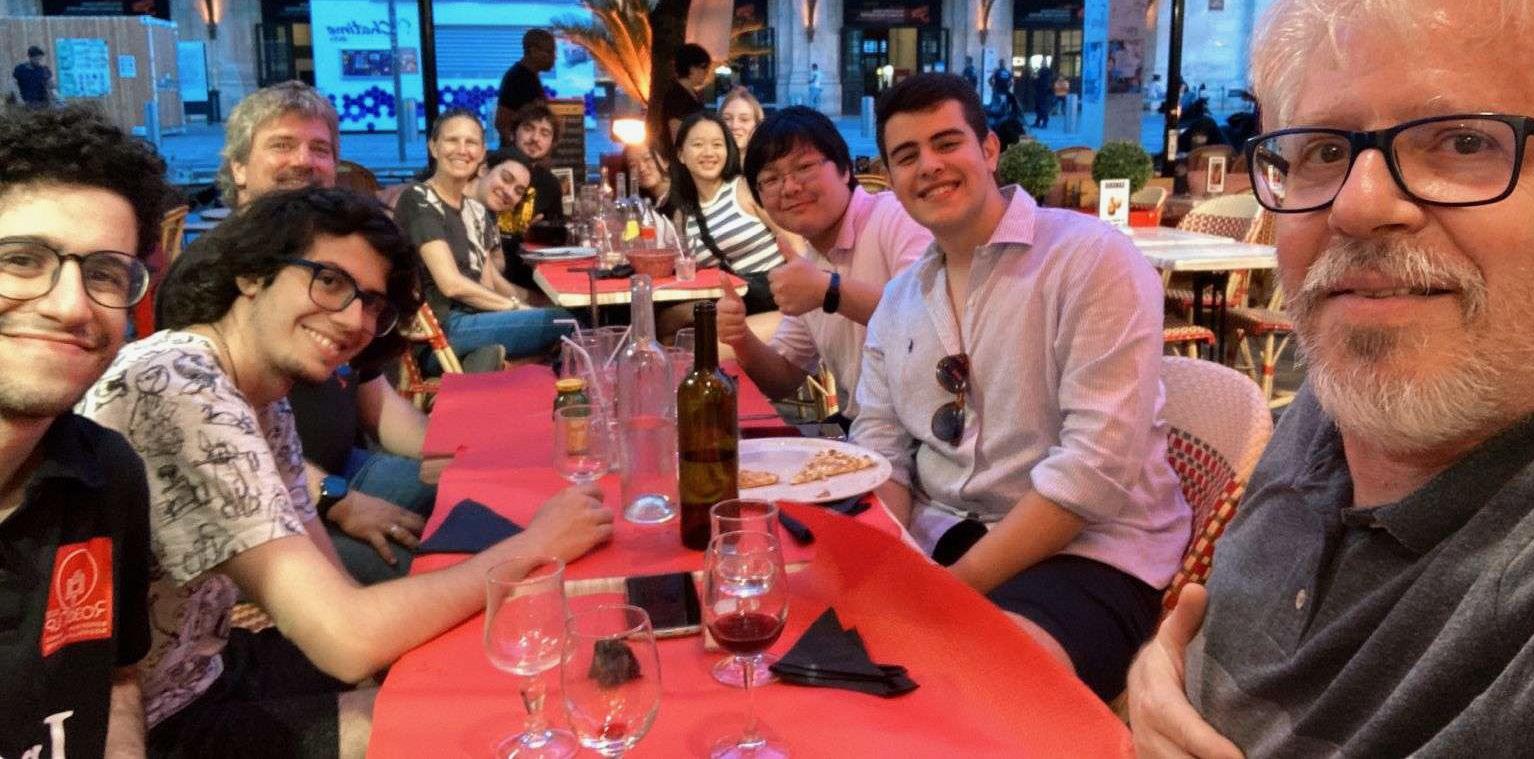
Although this competition wasn’t without many late nights of tearing apart then putting back together the robot or frustratingly unexpected course changes, it’s an experience I would without a doubt be proud to partake in again. As a team, the skills we’ve learned and people we’ve met through this experience are unforgettable, and we cannot wait to compete in RoboCup 2024 next July in The Netherlands’ technology hub — Eindhoven!

“A once-in-a-lifetime opportunity to meet people from all over the world”
22
Robots in the Industry League. Photo from RoboCup 2023’s Official Website
Dinner with the Brazillians!

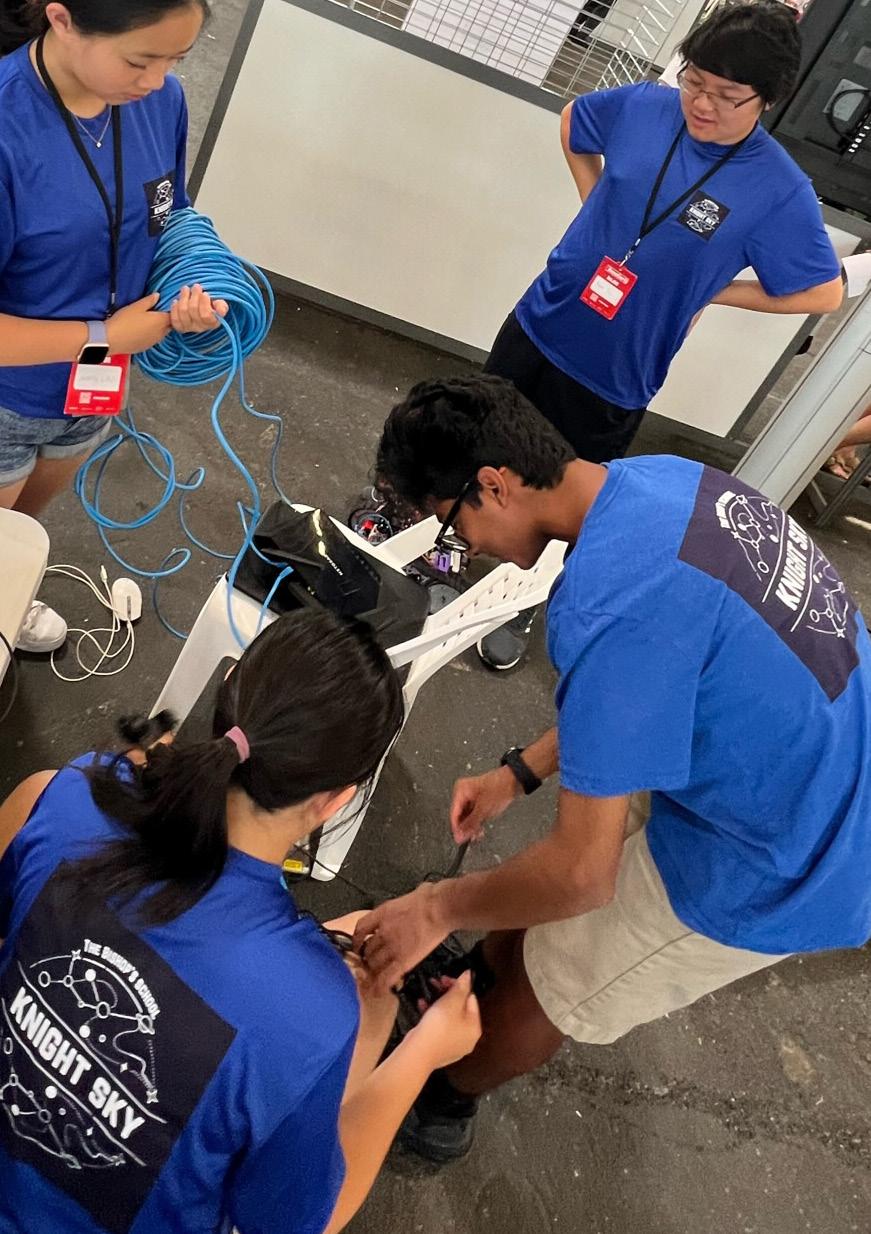

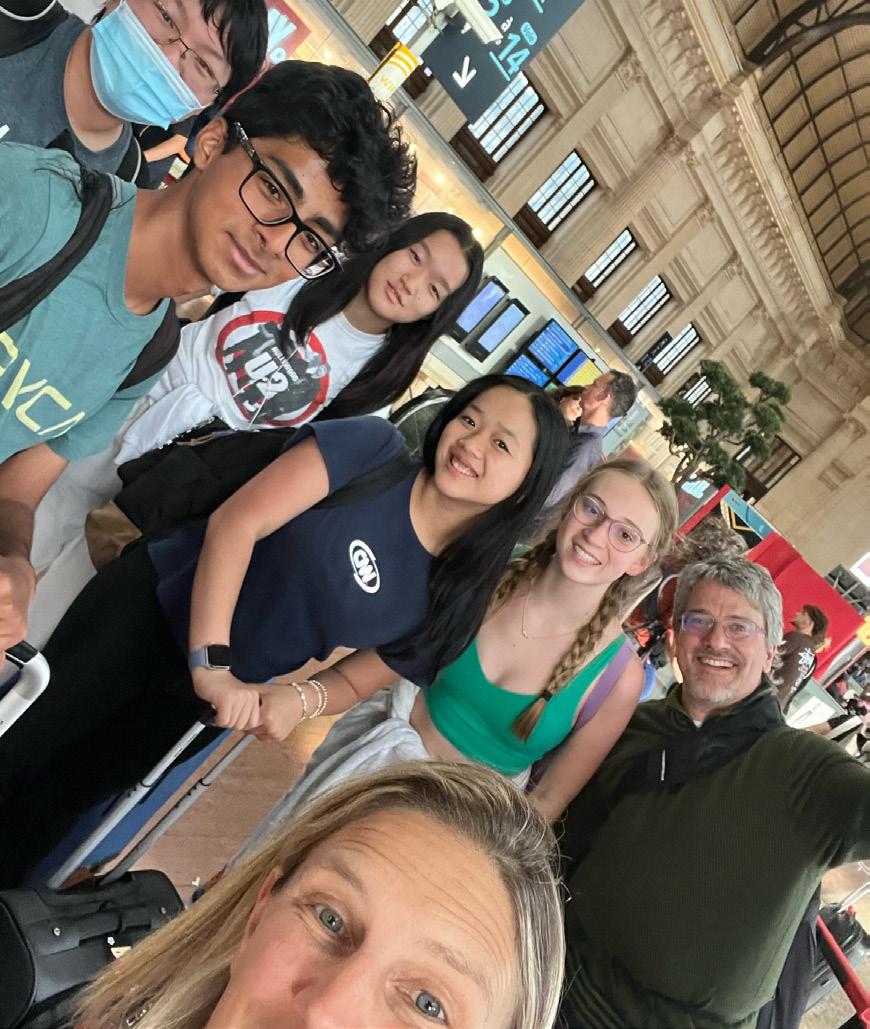
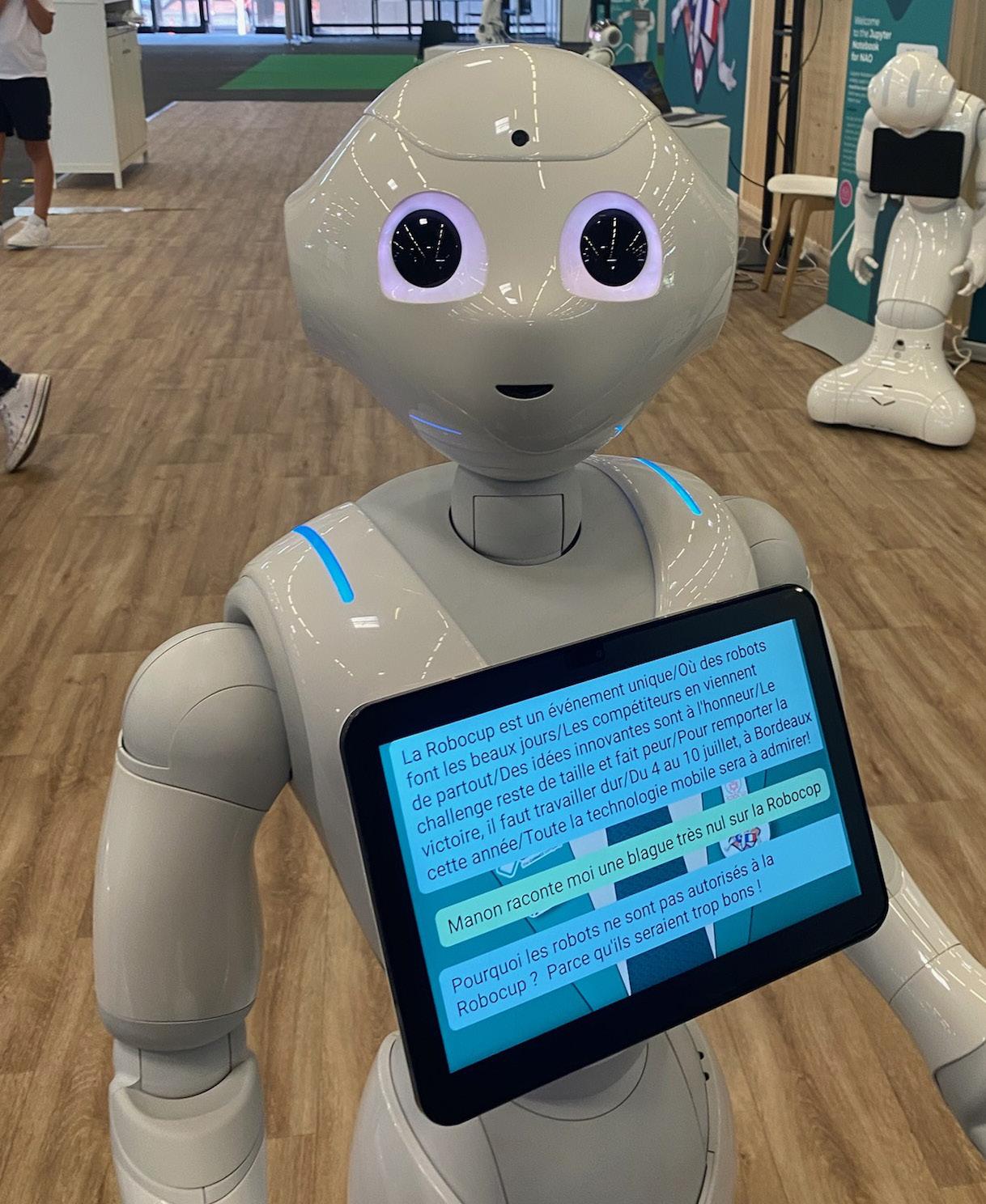
23
RoboCup 2023

Refocusing the Lens: Enhancing Differential
Dynamic Microscopy with Convolutional Neural Networks
By Emmie Kao ‘25
Thissummer, I had the opportunity to intern at a biophysics lab at the University of San Diego with Professors Rae Robertson-Anderson and Ryan McGorty. During this experience, I was able to work on a project that used convolutional neural networks, or CNNs, to enhance a form of image analysis called differential dynamic microscopy (DDM).
DDM is a form of image analysis used to quantify motion. Running an image (or set of images) through DDM results in an intermediate scattering function (ISF). Essentially, the importance of the ISF is that it can give us values that can tell us about how a microscopic system is moving (such as the diffusion coefficient, a value that tells us whether the system is diffusing randomly or moving on its own accord). However, one drawback of DDM is that it requires a large amount of image frames (or a larger video length) to output an accurate ISF. Here, a convolutional neural network (CNN) was utilized to enable accurate ISF generation with up to 100 times fewer frames. To do so, we recorded several-thousand-frame vid-
eos of microscopic proteins and microbeads to find target values for our ISFs and diffusion coefficients, then tested our model on 50-frame samples.
As a control dataset, we performed DDM on a large, multi-thousand-frame video. This gave us an accurate value for the diffusion coefficient so that we would be able to test our model as well as an accurate ISF to train it on. Then, we split the larger video into 50-frame samples to train and test the neural network.
Neural networks are one of the more complex forms of machine learning, essentially telling the computer to process information like a human brain. This involves the use of hidden layers, which are similar to regressions— essentially, they each have an input, a formula with weights and biases, and an output. A single neural network can have tens or even hundreds of hidden layers, each of which is modified through the training process. To train a machine learning model, it is fed labeled sets of data and updates its parameters
25
. A CNN, then, is a type of neural network. CNNs are used primarily for image identification and processing. They take an image as an input, similar to a matrix of color values, and pass a filter, or kernel, over the image (fig. 1). Doing this repeatedly results in a new version of the image, which in our case, is less noisy.
Neural networks tell the computer to process information like a human brain.
Our CNN was built as an autoencoder, which consists of two parts: an encoder to process the image through a series of kernels, or filters, before flattening it into one dimension; and a decoder to reverse the encoder’s filters to revert the image to its original size. This means that it will use an encoder to reduce the dimensions of an image to latent space, then use a decoder to return the image to its normal size, but without the noise.
The input for our CNN was the “noisy,” or rough, version of the ISF produced by only 50 frames of data. The autoencoder then ran that image through several layers to create a smoothed version (fig. 3) In (A), we can see that ISF with only 50 frames of raw data is relatively noisy. The encoder portion of our autoencoder, depicted in (B) and (C), first “flattens” the image. The data is encoded in a lower dimensional latent space, shown in (D). Then, the decoder reverses the encoder (shown in (E) and (F)), recreating the image so that the result is far smoother than before. Our ML-generated plot is shown in (G). Our autoencoder utilized mostly 2D Convolutional Models in addition to Rectified Linear Unit (ReLU) activation functions.
Our last step was to confirm that our model’s ISF was accurate (fig. 4). In order to do so, we used the diffusion coefficients from the CNN-generated ISF. In the above graphs, the black line represents the “target” diffusion coefficient, which we
calculated from the full set of frames. The graphical results show that our machine-learning ISFs resulted in far more accurate readings than data without being processed through the CNN-ED model. Additionally, to highlight that our model does not simply use a filter to smooth the ISF data, we compared our model’s results with that of a Gaussian filter. Our model continues to perform significantly better than the Gaussian one.
This means that shorter videos can now be analyzed using DDM. If a student were looking at a set of microscopic proteins that photobleach easily, they would only be able to acquire a limited amount of data. Or, a student might be working with a quickly changing system and would only want to analyze a certain part of their video. In cases like this, our machine learning model could be used to perform DDM on such datasets.
I was able to understand the process behind scientific research publications.
Working with a group of undergraduate students as well as Dr. McGorty on this project was a valuable experience in terms of both content and teamwork. While learning about the complexities of DDM and machine learning, I was also able to understand the process behind scientific research publications. Each person contributed to a specific aspect of the project, such as preparing samples, collecting data, training and testing the model, and generating graphs. Overall, it was a very valuable experience, and I highly recommend other students to take such internship opportunities should they arise.
26

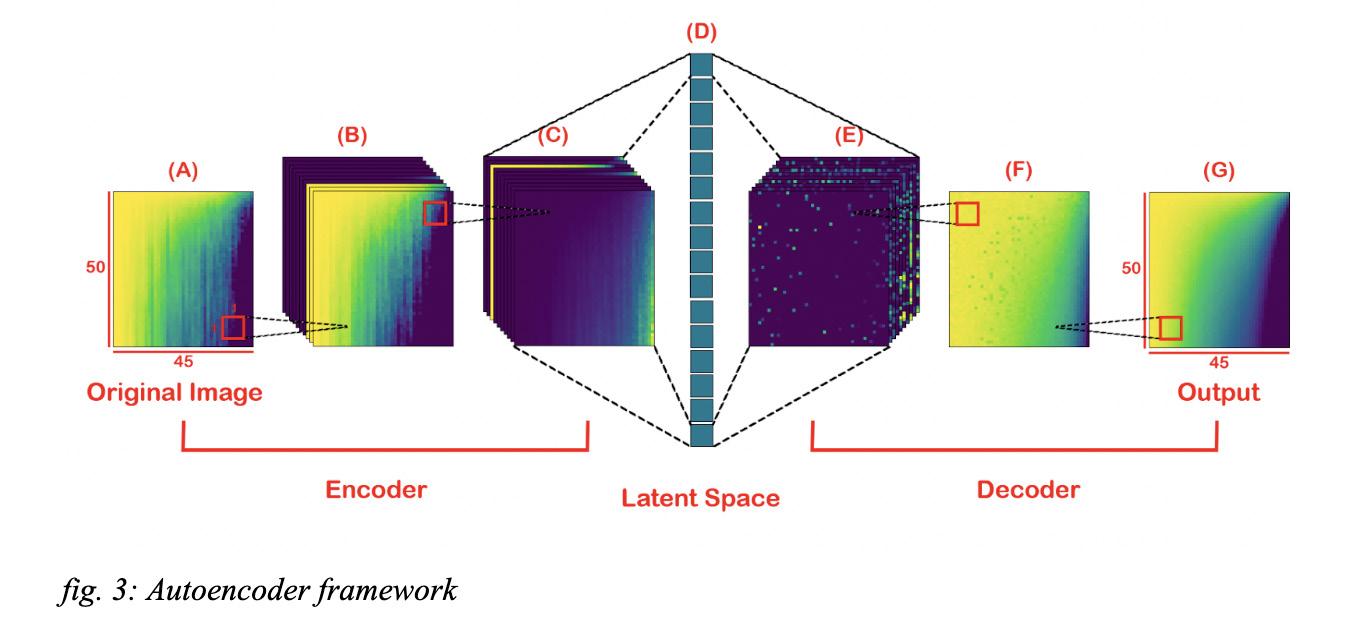

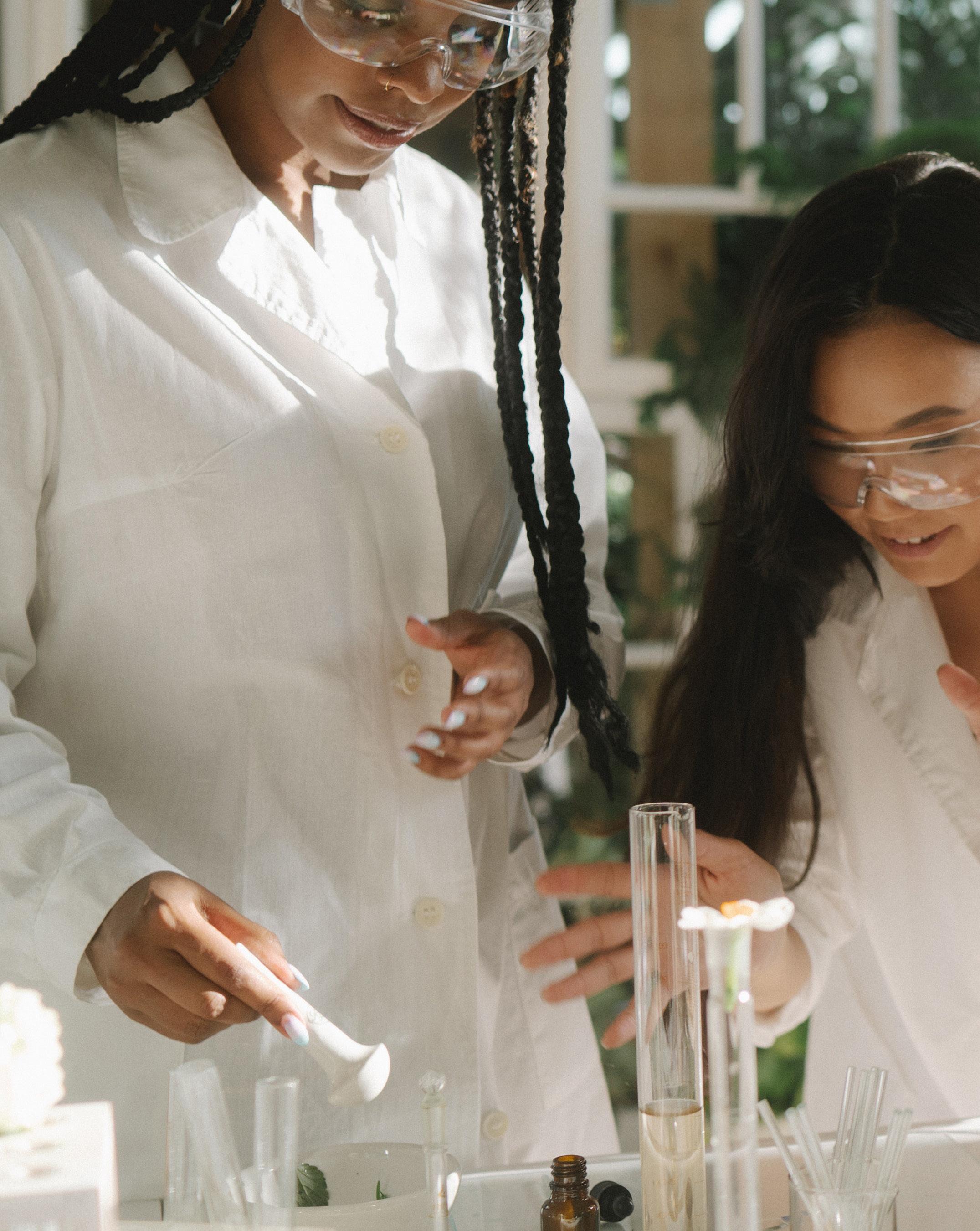
Women in STEM
By Paulina Ai ‘24
In 2009, 48% of the total workforce was female. In 2022, this percentage has not changed. What has, however, is the female workforce in STEM. In 2009, women made up 24% of STEM jobs, and that number has since risen to 34% as of March 2022 (NCGP). The 13 years it took for the number of women in STEM professions to rise 10% demonstrates the evolving role of women in STEM fields, yet it also demonstrates how slowly progress is moving.
In recent years, many positive things have happened for the advancement of women in STEM. This year, Stanford chemist and professor Carolyn Bertozzi, along with colleagues Morten Meldal and K. Barry Sharpless, has won the Nobel prize in Chemistry, making her the eighth woman out of 189 recipients of the Nobel Prize in Chemistry. Carolyn researched and developed bioorthogonal reactions, chemical reactions that allow research of biomolecules without interfering with natural chemical processes. In 2019, the world was shocked by the first ever image of a black hole. The development of the computer program used to help create this image was led by computer scientist Katie Bouman. According to the Postsecondary
Education Data System, of students majoring in a STEM related field, 45% are women, the STEM fields being specified as engineering, biological sciences, mathematics, and physical sciences(Forbes)
A detail that can be hidden by the percentages of women in the STEM workforce, however, is the state of women in specific fields. Particularly, according to the NCGP, engineering, computer science, and physics. While women in social sciences make up 65% of the professional workforce, and women in life sciences make up 48%, they make up only 26% and 16% of professional computer scientists and engineers, respectively. (NGCP) This means that although womenhave made incredible progress in entering and pursuing STEM as a career, there is still severe inequality in certain fields. The reason for the low numbers of women in engineering and computer science? The reasons vary:
A Harvard Business Review report states that due to the collaborative nature of engineering, women with a first taste of teamwork in college with people that belittle or patronize them can cause them to move away from engineering. In addition, internships in engineering and brief workplace experiences that
include sexual harassment, belittling, and are creatively limiting can turn women away from continuing engineering (HBR). In computer science, some say that the lack of introduction of computer science in youth is affecting the amount of women in the field. (Computer Science). Many reports cite the marketing of technology towards men, as well as the imagery of men being more “apt” at using computers has led to the institutionalized dissuasion of women entering computer science. (Computer Science, The Scientific American)
The intersectionality of sex, race, class, and ethnicity can combine to work against the longterm participation of girls in STEM. Latina, Black, and Indigenous women make up less than 10% of the workforce. Athena Hernandez is an avid computer scientist and senior at the Bishop’s school, who has been working on this issue. Athena spoke to me

at a disadvantage in skill when starting and they are not represented in the community. This keeps girls who have a spark of genuine passion for science out of one of the fastest growing professions in our day. Athena recognizes this and works towards encouraging Latina girls to continue computer science.
I also spoke to Michelle Vargas, a quality Systems Engineer in San Diego, who has been a professional Engineer for 26 years. When speaking with her, she mentioned the struggles of being a woman in the workplace, as well as a person of color. She commented on the way she was treated based on how she dressed. She shared her experience of keeping a straight face and waiting till she was alone in a bathroom to cry over her treatment. How then, did she stay in the field of engineering–a field where 40% of women who get a degree quit or never enter the profession? Her answer was the same as Athena’s. Her passion
The intersectionality of sex, race, class, and ethnicity can combine to work against the longterm participation of girls in STEM.
on the issues mentioned earlier, how- intersectionality wise- she was underrepresented not only as a woman, but also as a Latinx person. Athena mentions feeling intimidated at the beginning of her programming journey because of how much farther ahead others appeared to be. Her passion for programming, however, kept her pursuit of computer science. Athena says she feels a pressure to do better at computer science to be taken seriously, and that she feels a responsibility to be a role model for those that want to lead a career like her. Many girls feel discouraged starting computer science as they are often
for math and science at a young age took her from poverty in South America to life as a very successful engineer in San Diego, and her passion for STEM carried her through it all.
With sufficient role models from organizations like NCWIT (National Center for Women & Information Technology), AAUW (American Association of University Women), and SWE (Society of Women Engineers), as well as a change in the presentation of who should be in STEM, we can work towards the increase of women in STEM.
SUPPORT Girls in STEM
Founded by Bishop’s alum Veronica Tang (‘18), All Girls STEM Society (AGSS) is a 501(c) (3) nonprofit that seeks to ameliorate the gender gap in Stem. With branches at high schools throughout San Diego, AGSS hosts monthly workshops at local livrarues, annual Halloween/Holiday festivals, and a math tournament to encourage young girls to pursue their passions in stem, regardless of stigma and inequality in STEM fields. Workshop topics have include biology, cryptography, robotics, Rube Goldberg, and more! At Bishop’s, around 20 upper schoolers volunteer for AGSS! They meet every E Day in Ms. Williamson’s room.


Led by seniors Sophia Guan and Sienna Li, Girls Who Code (GWC), started last year, now boasts a membership of 30 Bishop’s students across all coding experience levels. Every G Day in the computer lab, GWC hosts coding-related games, short lessons, and group “lab” projects such as designing a website. It’s a fun and safe space to talk all things computer science and to digress freely about any topic, from AI to coding tools to ethics.
stem society code girlswho all girls

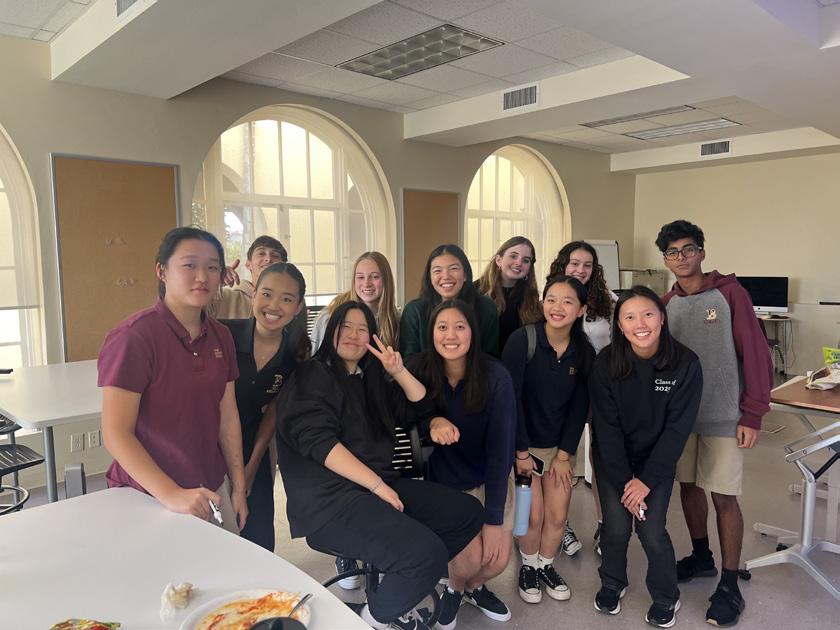
30
By Serena Zhang ‘24
STEM at BISHOP’S
The high school branch of Society of Women Engineers (SWE) is titled SWENext. As the next generation of girls begin to pursue their passions in engineering, SWENext provides valuable opportunities . Co-founded by Bianca Zorrilla (‘23) and Paulina Ai (‘24), The Bishop’s School’s SWENext club has engaged in multiple science fairs competitions, and even hosted its first hackathon at Bishop’s on December 16, 2023. SWENext meets on C Days in Mr. Milling’s room.


society ofwomen engineers
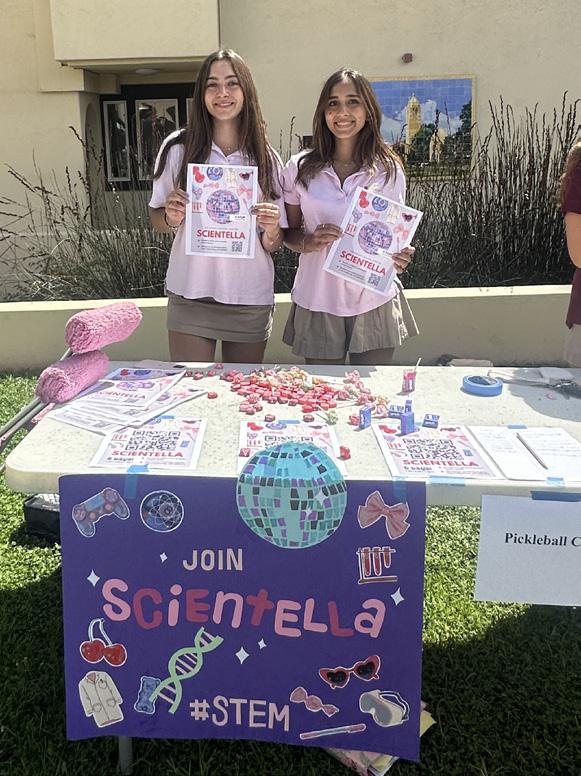

Started this year by seniors Sofi Verma and Sienna Garza, the Bishop’s Scientella club represents the larger Scientella community, which empowers the next generation of women in STEM. The organization matches girls with career-discovery opportunities and scholarships. Girls have the chance to consult for real world research with companies such as ResMed, Illumina, and more. Scientella meets with Dr. Keller in Wheeler Bailey.
We hope you consider joining or supporting these on-campus organizations! They carry hope for the future of girls in STEM. These clubs are selfless, collaborative, and fun, and they would love your support—no matter what form it takes!
31
scientella
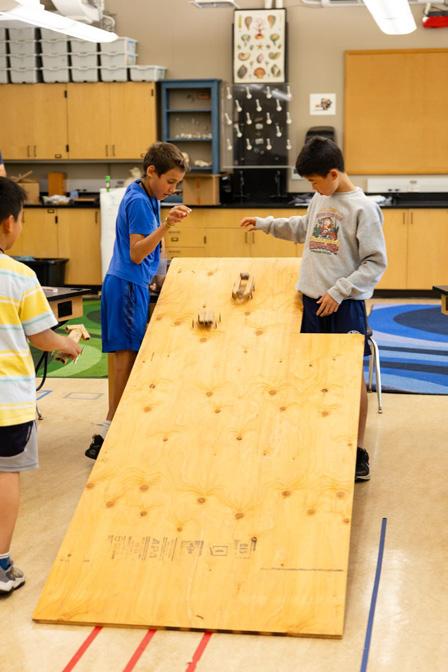


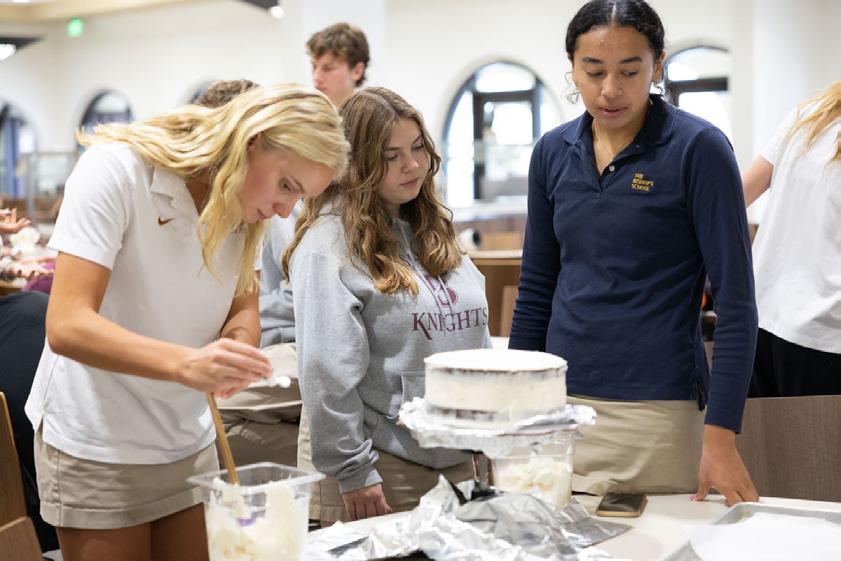



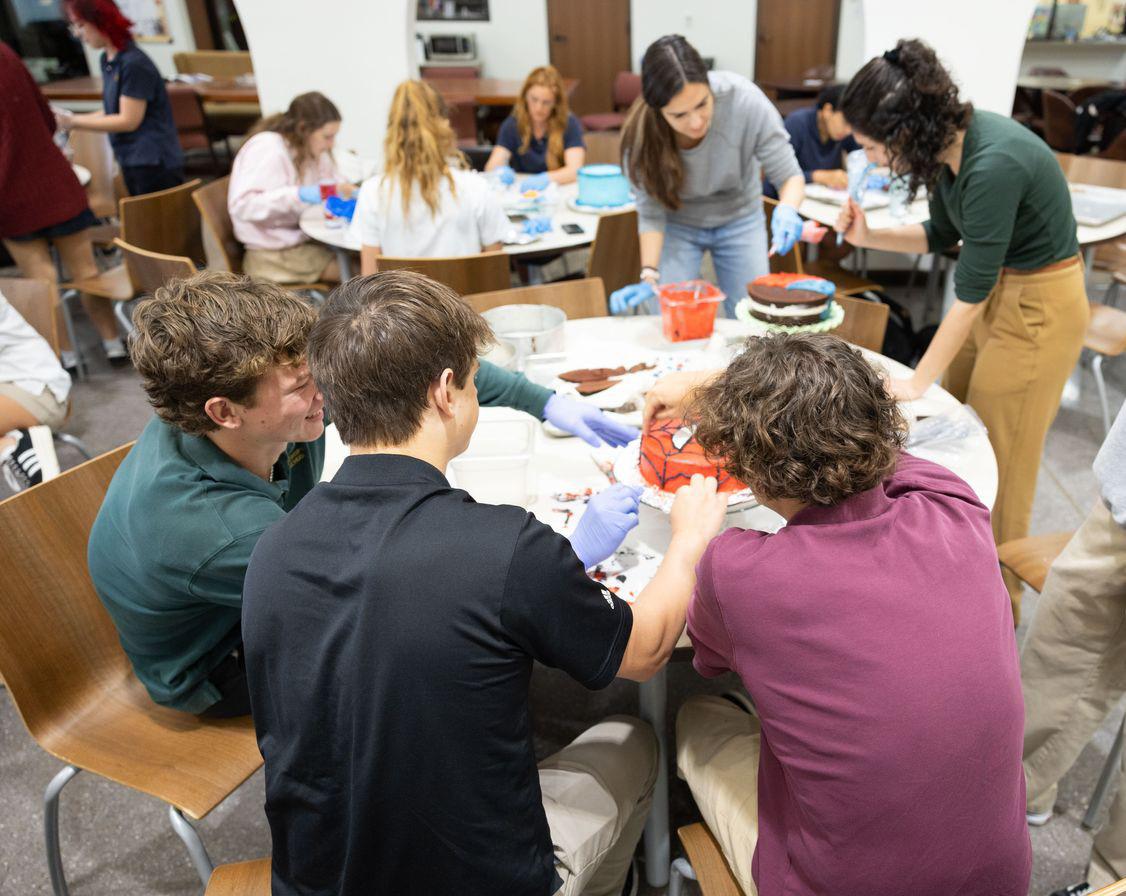



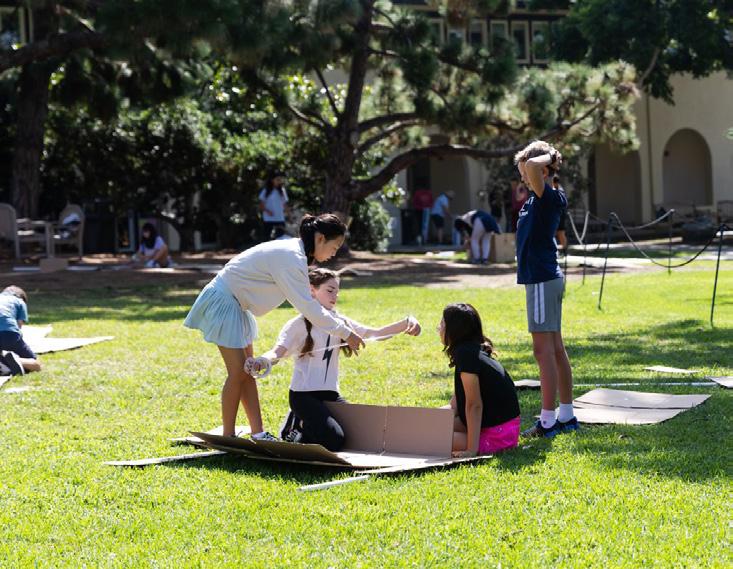
Science at Bishop’s
32
QUANTA STUDENT MAGAZINE
STUDENT
EDITORS
Tali Ben-Yehuda ‘25
Nora Bitar ‘25
Mia Gover ‘25
Emmie Kao ‘25
Hanna Liang ‘25
Audrey Lin ‘25
Ethan Yang ‘26
EDITOR IN CHIEF
Serena Zhang ‘24
LAYOUT
Seungbeom Baek ‘25
Tali Ben-Yehuda ‘25
Carley Chen ‘25
Hanna Liang ‘25
Audrey Lin ‘25
Sofi Verma ‘24
Serena Zhang ‘24
DIGITAL MEDIA
Carley Chen ‘25
Mia Gover ‘25
Hanna Liang ‘25
Audrey Lin ‘25
Serena Zhang ‘24
FACULTY SPONSOR
Ms. Laura Cummings
STAFF WRITERS
Paulina Ai
Tali Ben-Yehuda
Sofia Hayden
Chloe Hinder
Emmie Kao
Audrey Lin
Jasper Rose
Calista Upton
Kailin Xuan
Amy Yan
On the covers: Aurora Borealis (the “Northen Lights”) Source: Pexels
33

The Quanta Magazine is an entirely student-run science magazine for students to share their scientific passion with their peers.
Since its founding in 2010, Quanta has periodically released to The Bishop’s School and the broader community through print issues as well as online articles through their website. Quanta features student written articles about new and exciting scientific topics. All students are invited to write for Quanta, as we are always looking for new writers!



 Serena Zhang Editor-In-Chief Class of 2024
Serena Zhang Editor-In-Chief Class of 2024






























































